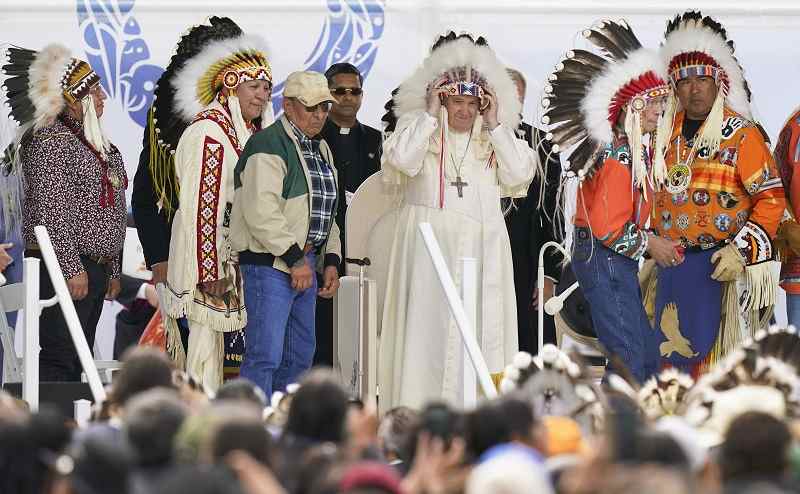
Pope Francis dons a headdress during a visit with Indigenous peoples at Maskwaci, the former Ermineskin Residential School, Monday, July 25, 2022, in Maskwacis, Alberta.
11:22 JST, July 27, 2022
It was a stunning image: Pope Francis briefly wearing a full Indigenous headdress, its rows of soft white feathers fastened in place by a colorful, beaded headband after he apologized for the Catholic Church’s role in Canada’s “disastrous” residential school system for Indigenous children.
Chief Wilton Littlechild, a residential school survivor himself, gave Francis the headdress Monday, placing it on his head amid cheering by an audience in Maskwacis, Alberta, that included many school survivors.
The Vatican and the pope clearly appreciated the gesture: Francis kissed Littlechild’s hands after receiving the headdress, something he has done in the past as a sign of respect for Holocaust survivors, and has done on this trip for residential school survivors.
The Vatican obviously understood the symbolic significance of the moment, putting the photo on the front page of the Vatican newspaper L’Osservatore Romano under the headline “I humbly beg forgiveness.”
Headdresses historically are a symbol of respect, worn by Native American war chiefs and warriors. For many Plains tribes, for example, each feather placed on a headdress has significance and had to be earned through an act of compassion or bravery. Some modern-day Native American leaders have been given war bonnets in ceremonies accompanied by prayers and songs.
Not everyone was pleased by Littlechild’s action. Some members of Indigenous tribes said they found the gesture incongruous with the past transgressions at church-run schools that Francis apologized for.
Russ Diabo, a member of the Kahnawake Mohawk tribe in Canada and an Indigenous advocate and policy analyst, described the scene as “pageantry” and the pope’s statements as “facile.”
Diabo said on Twitter it was “the Catholic Church and Canada collaborating in creating a mythology for a shared ‘Reconciliation’ agenda narrated by prominent federal collaborators/residential school survivors!”
“I have so much to say about this, and all of it negative,” tweeted Joe Horse Capture, vice president of native collections and curator of Native American History and Culture at the Autry Museum of the American West in Los Angeles.
“I am practicing ‘If you can’t say anything positive, don’t say anything at all’ mantra. But I’ll be honest, it’s difficult!,” added Horse Capture, a member of the A’aniiih Nation.
Maka Black Elk, executive director of Truth and Healing at Red Cloud Indian School in Pine Ridge, South Dakota, described the scene on Twitter as “a #toosoon moment.”
“The discourse around the #PopeFrancis headdress is unfortunate,” wrote Black Elk. “He did not request that. It wasn’t his fault. But it’s also clear the givers did not consider how it would make other Indigenous people feel.”
Black Elk said later in a telephone interview that the mixed reaction to the headdress being placed on the pope’s head “reflects the reality of native people and our need for more dialogue” about the past.
“I do think that Chief Littlechild felt it was important to honor this moment, and this was a significant moment,” he added.
A spokeswoman for Littlechild didn’t immediately respond Tuesday to a message seeking comment.
But Keeshon Littlechild used a Facebook post to defend his grandfather for giving Francis one of his own many headdresses.
“Bugs me to see people bashing my grandfather and I understand how much respect is needed to be gifted one but at the end of the day that was him showing the pope respect for coming all the way to maskwacis to apologize,” he wrote.
Among those coming to Littlechild’s defense was Phil Fontaine, a former Assembly of First Nations chief and a residential school survivor.
“Chief Littlechild followed his protocols,” Fontaine said. “There is a protocol for that kind of gift. He went to the elders, he went to the leadership and requested permission to present that gift. It is entirely consistent with the way they follow their customs and protocol here.”
Jon Crier, a First Nations elder and school survivor, said during a news conference after the apology that the gesture meant tribal leaders “adopted him as one of our leaders in the community.
“It’s an honoring of the man, it’s an honoring of the work he has done and it’s also recognizing … here’s a man that belongs in our tribe,” Crier said.
Marie-Anne Day Walker Pelletier, former chief of Okanese First Nation, told CTV, “I thought it was pretty cool. The chief of all chiefs now I guess.”
"News Services" POPULAR ARTICLE
-

American Playwright Jeremy O. Harris Arrested in Japan on Alleged Drug Smuggling
-

Japan’s Nikkei Stock Average as JGB Yields, Yen Rise on Rate-Hike Bets
-

Japan’s Nikkei Stock Average Licks Wounds after Selloff Sparked by BOJ Hike Bets (UPDATE 1)
-

Japan’s Nikkei Stock Average Buoyed by Stable Yen; SoftBank’s Slide Caps Gains (UPDATE 1)
-

Japanese Bond Yields Zoom, Stocks Slide as Rate Hike Looms
JN ACCESS RANKING
-

Tokyo Economic Security Forum to Hold Inaugural Meeting Amid Tense Global Environment
-

Keidanren Chairman Yoshinobu Tsutsui Visits Kashiwazaki-Kariwa Nuclear Power Plant; Inspects New Emergency Safety System
-

Imports of Rare Earths from China Facing Delays, May Be Caused by Deterioration of Japan-China Relations
-

University of Tokyo Professor Discusses Japanese Economic Security in Interview Ahead of Forum
-

Japan Pulls out of Vietnam Nuclear Project, Complicating Hanoi’s Power Plans

























